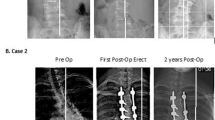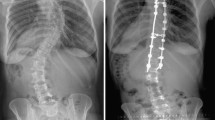Abstract
Study Design
Retrospective review of multicenter data set with adolescent idiopathic scoliosis (AIS) patients with at least 2 years of follow-up after posterior spinal instrumentation and fusion (PSIF).
Objectives
The purpose of this study is to investigate risk factors for coronal decompensation 2 years after PSIF for AIS.
Summary of Background Data
Coronal decompensation is a potential complication of spinal instrumentation for AIS. This can result in problems requiring revision surgery.
Methods
Demographic, clinical, and radiographic measures were reviewed on 890 identified patients. Coronal decompensation was defined as a change farmer away from midline from 6 weeks postoperatively to 2 years in any one of the following radiographic parameters: change in coronal balance >2 cm; change in coronal position of the lowest instrumented vertebra (LIV) >2 cm; change in thoracic trunk shift >2 cm; or change in LIV tilt angle > 10°. Patients with decompensation were compared to those without. The relationship between the LIV and lowest end vertebra (LEV) was examined as an independent variable.
Results
Two years postoperation, 6.4% (57/890) of patients exhibited coronal decompensation. Multivariate regression revealed that decompensated patients were twice as likely to be male, have lower preoperative Risser score, and lower percentage major curve correction. The relationship between the LIV and LEV as well as quality of life surveys were not significantly different between decompensated and nondecompensated patients at 2 years.
Conclusions
Two years after PSIF, 6.4% of patients with AIS exhibit radiographic coronal decompensation. Although this study did not demonstrate a significant association between the relationship of LIV and LEV and decompensation 2 years postoperation, results of this study indicate that skeletal immaturity, male gender, and less correction of the major curve may be related to higher rates of coronal decompensation.
Similar content being viewed by others
References
Angevine PD, McCormick PC. The importance of sagittal balance: how good is the evidence? J Neurosurg Spine 2007;6:101–3; discussion 3.
Betz RR, Harms J, Clements 3rd DH, et al. Comparison of anterior and posterior instrumentation for correction of adolescent thoracic idiopathic scoliosis. Spine (Phila Pa 1976) 1999;24:225–39.
Edwards 2nd CC, Lenke LG, Peelle M, et al. Selective thoracic fusion for adolescent idiopathic scoliosis with C modifier lumbar curves: 2- to 16-year radiographic and clinical results. Spine (Phila Pa 1976) 2004;29:536–46.
Lenke LG, Betz RR, Bridwell KH, et al. Spontaneous lumbar curve coronal correction after selective anterior or posterior thoracic fusion in adolescent idiopathic scoliosis. Spine (Phila Pa 1976) 1999;24:1663–71; discussion 72.
Moe JH. A critical analysis of methods of fusion for scoliosis; an evaluation in two hundred and sixty-six patients. J Bone Joint Surg Am 1958;460:529–54.
Potter BK, Kuklo TR, Lenke LG. Radiographic outcomes of anterior spinal fusion versus posterior spinal fusion with thoracic pedicle screws for treatment of Lenke type I adolescent idiopathic scoliosis curves. Spine (Phila Pa 1976) 2005;30:1859–66.
Patel PN, Upasani VV, Bastrom TP, et al. Spontaneous lumbar curve correction in selective thoracic fusions of idiopathic scoliosis: a comparison of anterior and posterior approaches. Spine (Phila Pa 1976) 2008;33:1068–73.
Arlet V, Marchesi D, Papin P, et al. Decompensation following scoliosis surgery: treatment by decreasing the correction of the main thoracic curve or “letting the spine go”. Eur Spine J 2000;9:156–60.
Bridwell KH, McAllister JW, Betz RR, et al. Coronal decompensation produced by Cotrel-Dubousset “derotation” maneuver for idiopathic right thoracic scoliosis. Spine (Phila Pa 1976) 1991;16:769–77.
Thompson JP, Transfeldt EE, Bradford DS, et al. Decompensation after Cotrel-Dubousset instrumentation of idiopathic scoliosis. Spine (Phila Pa 1976) 1990;15:927–31.
Behensky H, Cole AA, Freeman BJ, et al. Fixed lumbar apical vertebral rotation predicts spinal decompensation in Lenke type 3C adolescent idiopathic scoliosis after selective posterior thoracic correction and fusion. Eur Spine J 2007;16:1570–8.
PhDx Systems Inc. The Clinical Data Experts, http://www.phdx.com/. Accessed 6/16/2011. In.
O’Brien M, Kuklo T, Blanke K, et al. Spinal Deformity Study Group radiographic measurement manual. Memphis, TN: Medtronic, Sofomore Danek; 2008.
Wang SF, Qiu Y, Zhu ZZ, et al. Assessment of the residual spine growth potential in idiopathic scoliosis by risser sign and histological grading. Zhonghua Yi Xue Za Zhi 2008;88:461–4.
Wang S, Qiu Y, Ma Z, et al. Histologic, risser sign, and digital skeletal age evaluation for residual spine growth potential in Chinese female idiopathic scoliosis. Spine (Phila Pa 1976) 2007;32:1648–54.
Noordeen MH, Haddad FS, Edgar MA, et al. Spinal growth and a histologic evaluation of the Risser grade in idiopathic scoliosis. Spine (Phila Pa 1976) 1999;24:535–8.
Roberto RF, Lonstein JE, Winter RB, et al. Curve progression in Risser stage 0 or 1 patients after posterior spinal fusion for idiopathic scoliosis. J Pediatr Orthop 1997;17:718–25.
Sanders JO, Herring JA, Browne RH. Posterior arthrodesis and instrumentation in the immature (Risser-grade-0) spine in idiopathic scoliosis. J Bone Joint Surg Am 1995;77:39–45.
Biondi J, Weiner DS, Bethem D, et al. Correlation of Risser sign and bone age determination in adolescent idiopathic scoliosis. J Pediatr Orthop 1985;5:697–701.
Imrie M, Yaszay B, Bastrom TP, et al. Adolescent idiopathic scoliosis: should 100% correction be the goal? J Pediatr Orthop 2011;31:S9–13.
Mladenov KV, Vaeterlein C, Stuecker R. Selective posterior thoracic fusion by means of direct vertebral derotation in adolescent idiopathic scoliosis: effects on the sagittal alignment. Eur Spine J 2011;20:1114–7.
Takayama K, Nakamura H, Matsuda H. Quality of life in patients treated surgically for scoliosis: longer than sixteen-year follow-up. Spine (Phila Pa 1976) 2009;34:2179–84.
Patwardhan AG, Rimkus A, Gavin TM, et al. Geometric analysis of coronal decompensation in idiopathic scoliosis. Spine (Phila Pa 1976) 1996;21:1192–200.
Author information
Authors and Affiliations
Corresponding author
Additional information
Author disclosures: JAG (none); HM (nonfinancial support from Spinal Deformity Study Group, during the conduct of the study; grants from Scoliosis Research Society, grants from Pediatric Orthopedic Society of North America, grants from Children’s Spine Foundation (Grant no.: CWSD005, CWSD0004, CWSD0022, CWSD0026, CWSD0049), grants from Cerebral Palsy International Research Foundation (CPIRF Grant no.: R-808-12), grants from AOSpine, outside the submitted work); NDC (Spinal Deformity Study Group, during the conduct of the study); DPR (Spinal Deformity Study Group, during the conduct of the study; nonfinancial support from Stryker, grants from Scoliosis Research Society, grants from Pediatric Orthopaedic Society of North America, grants from Cerebral Palsy International Research Foundation, other from International Society of Orthopaedic Surgery and Traumatology, nonfinancial support from Children’s Spine Foundation (Grant no.: CWSD005, CWSD0004, CWSD0022, CWSD0026, CWSD0049), grants from Chest Wall and Spine Deformity Research Foundation, grants from AOSpine, grants from Orthopaedic Research and Education Foundation, grants and nonfinancial support from Medtronic, grants from OMeGA (Grant no.: 001167, nosh5532NO, 000786), grants from Biomet, nonfinancial support from Broadwater [Biomet, Synthes, Stryker, Medtronic, K2], outside the submitted work); DJS (none); BSR (Wolters Kluwer HealthdLippincott Williams & Wilkins, other from Pfizer, outside the submitted work; and board member/committee member, Scoliosis Research Society; Medical/Orthopaedic Publications Editorial Governing Board, Journal of Pediatric Orthopaedics); JBE (Medtronics spine, other from Synthes spine, outside the submitted work); MAE (none); JOS (Grants from Children’s Spine Foundation (Grant no.: CWSD005, CWSD0004, CWSD0022, CWSD0026, CWSD0049), grants from POSNA, grants from National Institute of Arthritis and Musculoskeletal and Skin Diseases (Grant no.: 2RO1AR052113), outside the submitted work; stock owner of Abbott Labs, GE, Hospira, and Abbvie); LGL (Grants from Axial Biotech, grants from DePuy-Synthes, grants from AOSpine/SRS/Norton Healthcare, other from AOSpine, other from John and Marcella Fox Research Agreement, personal fees from Medtronic, personal fees from K2M, personal fees from DePuy-Synthes Spine, personal fees from Medtronic, personal fees from Quality Medical Publishing, outside the submitted work); MGV (Spinal Deformity Study Group, during the conduct of the study; other from AAP Section on Orthopaedics, personal fees, nonfinancial support and other from CWSDSG, personal fees from Stryker, personal fees from Biomet, grants from AOSpine, grants from Children’s Spine Foundation (Grant no.: CWSD005, CWSD0004, CWSD0022, CWSD0026, CWSD0049), grants from Orthopaedic Research and Education Foundation, grants from SRS, grants and other from POSNA, grants and nonfinancial support from Medtronic, grants from OMeGA, nonfinancial support from Broadwater [Biomet, Syntes, Stryker, Medtronic, K2], nonfinancial support from FoxPSDSG, outside the submitted work).
This study was performed through the Spinal Deformity Study Group (SDSG), which was funded by Medtronic Sofamor Danek.
Rights and permissions
About this article
Cite this article
Gomez, J.A., Matsumoto, H., Colacchio, N.D. et al. Risk Factors for Coronal Decompensation After Posterior Spinal Instrumentation and Fusion in Adolescent Idiopathic Scoliosis. Spine Deform 2, 380–385 (2014). https://doi.org/10.1016/j.jspd.2014.05.001
Received:
Revised:
Accepted:
Published:
Issue Date:
DOI: https://doi.org/10.1016/j.jspd.2014.05.001




